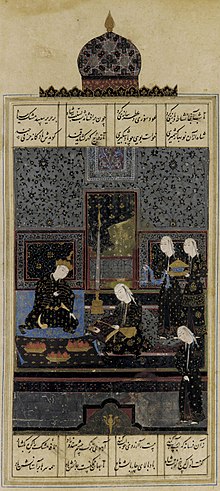ایرانی آذربائیجان
(آذربائیجان (ایران) توں مڑجوڑ)

آذربائیجان (Azerbaijan) (فارسی: آذربایجان; آزربائیجانی: آذربایجان) جسنوں ایرانی آذربائیجان تے فارسی آذربائیجان وی کہیا جاندا اے شمال مغربی ایران وچ اک علاقہ اے۔[۱] علاقے نوں جنوبی آذربائیجان وی کہیا جاندا اے۔ پر بعض اہل علم تے ذرائع دے مطابق ایہ رجوعی تے سیاست طور اُتے اے۔[۲][۳][۴]
ثقافت[سودھو]

آذربائیجان دا ذکر اکثر کتاباں وچ ملدا اے :
گزیده هر چه در ایران بزرگان
زآذربایگان و ری و گرگان
فخرالدين اسعد گرگانی دی داستاں محبت ويس و رامين توں
از آنجا بتدبیر آزادگان
بیامد سوی آذرآبادگان
به یک ماه در آذرآبادگان
ببودند شاهان و آزادگان
ہور ویکھو[سودھو]
مورتاں[سودھو]
حوالے[سودھو]
- ↑ James Minahan. "Miniature Empires", Published by Greenwood Publishing Group, 1998.
- ↑ Michael P. Croissant, "The Armenia-Azerbaijan Conflict: Causes and Implications", Praeger/Greenwood, 1998. excerpt from pg 61: "During the Soviet-era historical revisionism and myth-building intended to denounce imperialism, the notion of a "northern" and "southern" Azerbaijan was created and propagated throughout USSR. It was charged that the "two Azerbaijanis" once united were separated artificially by conspiracy between imperial Russia and Iran".
- ↑ Ethnic Conflict and International Security, Edited by Michael E. Brown, Princeton University Press, 1993
- ↑ Bert G. Fragner, ‘Soviet Nationalism’: An Ideological Legacy to the Independent Republics of Central Asia ’ in” in Van Schendel, Willem(Editor) . Identity Politics in Central Asia and the Muslim World: Nationalism, Ethnicity and Labour in the Twentieth Century. London , GBR: I. B. Tauris & Company, Limited, 2001. Excerpt from pg 24: "Under Soviet auspices and in accordance with Soviet nationalism, historical Azerbaijan proper was reinterpreted as 'Southern Azerbaijan', with demands for liberation and, eventually, for 're'-unification with Northern (Soviet) Azerbaijan a breathtaking manipulation. No need to point to concrete Soviet political activities in this direction, as in 1945–46 etc. The really interesting point is that in the independent former Soviet republics this typically Soviet ideological pattern has long outlasted the Soviet Union."
| وکیمیڈیا کامنز چ مورتاں: ایرانی آذربائیجان |




